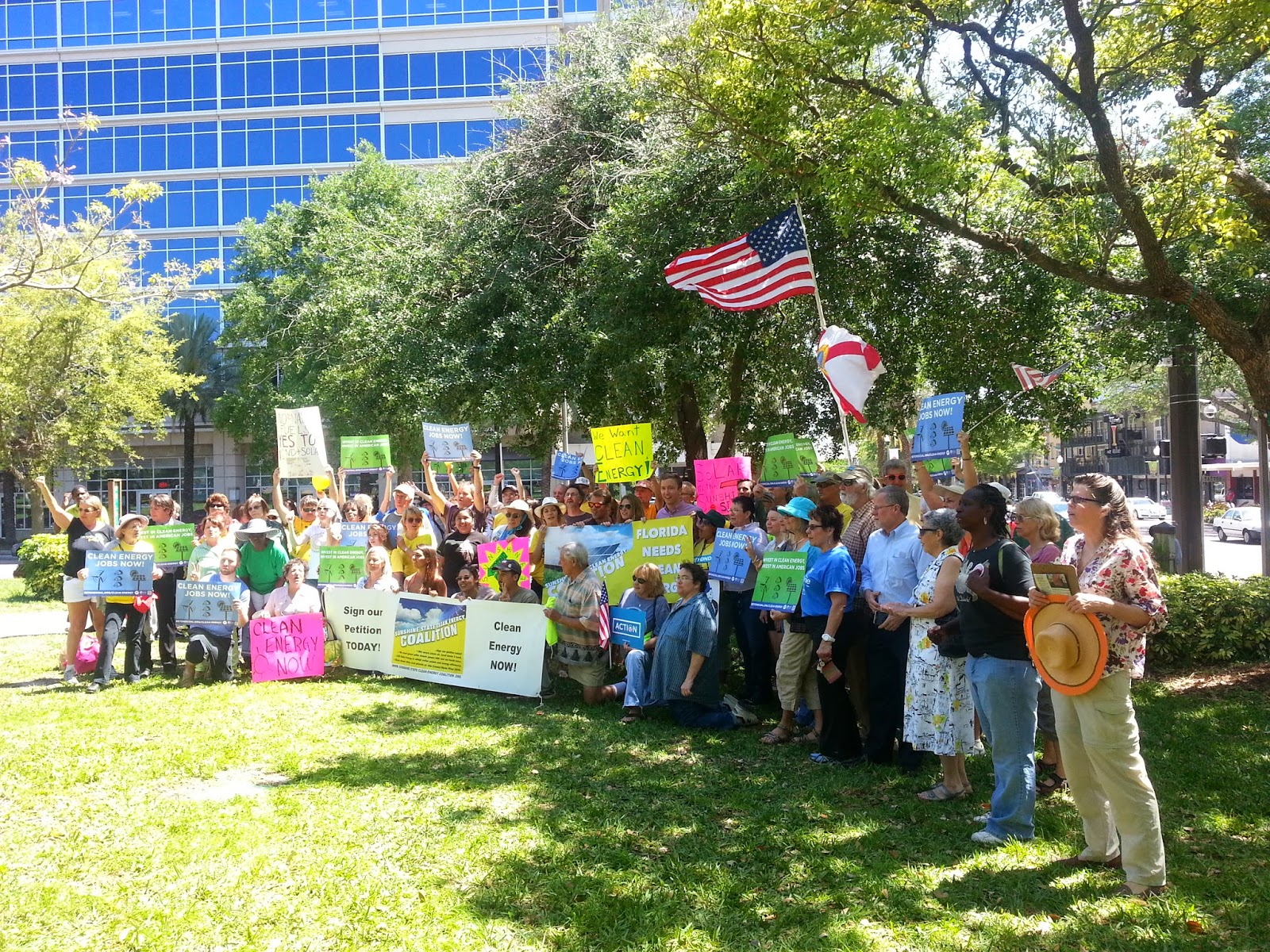5,500 Floridians Tell Duke Energy to Choose Clean Energy Now
Crowd Rallies at Duke Energy's Florida Headquarters Calling for Solar Power and Clean Energy Jobs

ST. PETERSBURG, FL — A crowd of 140 clean air advocates rallied outside Duke Energy's Florida headquarters on April 2, 2014 and delivered nearly 6,000 signatures of St. Pete and Tampa Bay area residents calling on the region's largest utility company to move beyond coal to clean energy. The Sunshine State Clean Energy Coalition, led by the Sierra Club, launched in November of 2013 and has already grown to encompass more than two dozen member groups, representing faith, labor, business and health advocates in Florida. The rally took place the day after Duke Energy told state regulators that its ten year plan does not include provisions for new or expanded energy efficiency or clean energy projects.
"Hundreds of concerned residents turned out today to send a strong message to Duke Energy: it's time to invest in Florida's economy and people by choosing our homegrown energy resources over obsolete, expensive and dirty imported fuels," said Julia Hathaway, organizer with Sierra Club in Florida. "We know that Duke, the nation's largest utility, is building solar power and investing in energy savings in other states. But here in Florida, Duke is stalling, and wants to keep sending our energy dollars out of state. It's time for the Sunshine State to see real investment in solar energy and energy efficiency solutions that will create jobs and clean up our air."

Members of the coalition collected more than 5,500 petition signatures by talking primarily with Duke Energy customers in Pinellas County and the Tampa Bay area. The coalition believes it's important for Duke, now the nation's largest utility company, to hear directly from customers about the company's inadequate solar and energy savings programs. Duke Energy's Ohio and North Carolina operations are significantly outperforming its Florida arm, leaving its customers in the Sunshine State with higher energy bills and fewer opportunities. In fact, in Ohio Duke is among the nation's best performing utilities, saving more than four times more energy than Duke in Florida, letting customers in Ohio reap the benefits.
"Civic engagement signifies the presence of an informed electorate and is critical to a thriving democracy. Civic engagement can be seen as a nuisance to corporations, but Duke should consider this demonstration as a favor. These 5,500-plus petitions serve to let Duke Energy know that there is consumer demand for energy efficiency and solar power in Florida," said Kofi Hunt, project coordinator with Awake Pinellas.
Florida is ranked in the bottom half of states by the American Coalition for an Energy Efficient Economy's (ACEEE) annual ranking, specifically because of utilities' under-investment in energy savings programs.
"I live in Brooksville and when I drive to the beach at Pine Island, I can see the Crystal River Power Plant off in the distance near the shoreline. I am concerned that this is the largest source of mercury pollution in the state and that it is polluting the air we breathe, the land where we grow our food and coastal waters where we fish," said DeeVon Quirolo, marine conservationist and founder of Reef Relief, and a Hernando County activist. "It's time for Duke to retire obsolete its coal units #1 and #2 at Crystal River. It's time for clean energy here in the Sunshine State and Duke should be promoting energy conservation so our power bills go down."

Duke Energy operates four coal-burning units at its Crystal River power plant in Citrus County, FL. In recent filings to state regulators, the company has committed to phasing out coal burning at two of the units by 2018, but currently plans to increase natural gas use at the plant instead. By delaying its plans to phase out burning coal at the Crystal River plant, Duke Energy is choosing to produce four more years of air pollution, including toxic mercury pollution, which will impact children, seniors and people living with asthma and other respiratory illness.
"By shutting down the dirtiest power plants, like Crystal River, using energy more efficiently, and by generating more power from clean, renewable sources like the sun, we could be delivering a one-two punch in the fight against climate change, and ensuring the health and safety of our communities for years to come," said Jennifer Rubiello, field associate with Environment Florida, based in Tallahassee.
Nationwide, 162 coal-fired power plants have been locked in for retirement since 2010 as coal generation declined by nearly one-fifth in two years. At the same time, clean energy production has skyrocketed, with wind providing more than 20% of Iowa and South Dakota's power, and more than 10% of Texas and Oklahoma's power. In 2013, more than 13,000 megawatts of solar power are now connected to the grid, powering homes and businesses.